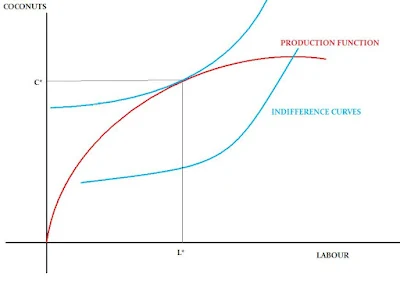Production Function
For the production of any good, various factors are necessary, such as land, capital, labor, organization or enterprise, technology, etc. For example, consider the production of rice. When a farmer produces rice, they use land, labor, ploughs, hoes, tractors, seeds, chemical fertilizers, etc.
These are the factors of production. Changing these factors of production also changes the quantity of rice produced. Increasing these factors of production increases rice production, while decreasing them reduces rice production.
Therefore, the technical relationship between the quantity of output and the factors of production is called the production function. The production function can be expressed symbolically as follows:
Q = f(L, K, N, M, T)
Where,
Q = Output
L = Labor
K = Capital
N = Land
M = Management
T = Technology
f = Function
Including all factors of production in the production function makes production analysis difficult. Therefore, instead of including all factors, the production function is shown by including only two important factors: labor and capital, which is as follows:
Q = f(L, K)
Types of Production Function
There are two types of production functions, which are as follows:
(a) Short-Run Production Function:
The short-run production function shows how output changes when only one factor of production or the variable factor is changed, while other factors of production are kept constant. In other words, in the short-run production function, only one factor of production is variable, and other factors of production remain constant. The short-run production function explains the law of variable proportions. It can be expressed symbolically as follows:
Q = f(L, K̄)
Here, K̄ is capital, which is a fixed factor of production.
On the other hand, L is labor, which is a variable factor of production.
(b) Long-Run Production Function:
The long-run production function shows how output changes when all factors of production are changed. In other words, in the long-run production function, all factors of production are variable. The long-run production function shows the law of returns to scale. It can be expressed symbolically as follows:
Q = f(L, K)
Here, both K (capital) and L (labor) are variable factors of production.
Example: Suppose a firm’s production function is given by the equation:
Q = 2L^0.5 K^0.5
Where,
Q = Output
L = Labor
K = Capital
If the firm employs 16 units of labor and 25 units of capital, the total output can be calculated as follows:
Q = 2(16^0.5) (25^0.5)
= 2(4) (5)
= 2 × 20
= 40 units
Thus, the total output of the firm is 40 units.
Importance of Production Function
The production function plays a vital role in economics and business decision-making. Its importance can be explained as follows:
Efficient Resource Allocation: It helps firms determine the optimal combination of inputs to maximize output while minimizing costs.
Decision Making: It aids businesses in making crucial decisions regarding investment in capital and hiring labor.
Understanding Returns to Scale: It helps businesses understand whether increasing inputs will proportionally increase output, allowing them to plan for expansion.
Cost Minimization: By analyzing the production function, firms can adjust their input usage to achieve the lowest cost of production.
Policy Formulation: Governments and policymakers use production functions to frame policies related to industrial growth, labor employment, and resource management.
Applications of Production Function
The concept of the production function is widely applied in various fields, including:
Business and Manufacturing: Companies use production functions to determine how changes in labor and capital affect overall production.
Agriculture: Farmers analyze production functions to decide the optimal use of land, labor, and machinery to maximize crop yield.
Economic Growth Analysis: Economists use aggregate production functions to study national output and productivity trends.
Technological Innovation: It helps businesses assess the impact of new technologies on productivity and efficiency.
Project Planning and Feasibility Studies: Firms and governments use production functions to evaluate the feasibility and profitability of new projects.






.jpeg)


 The Economic Frontline is a knowledge-driven platform offering thoughtful economic perspectives, policy-focused, and analytical content on national and global financial trends.
The Economic Frontline is a knowledge-driven platform offering thoughtful economic perspectives, policy-focused, and analytical content on national and global financial trends.
